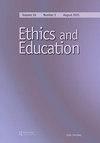Herbart with Rancière on the Educational Significance of the ‘Third Thing’ in Teaching
IF 0.7
Q3 EDUCATION & EDUCATIONAL RESEARCH
引用次数: 0
Abstract
ABSTRACT This article highlights the educational and the aesthetic significance of the subject matter (i.e., “the third thing”) in the relationship between teacher and pupil. This, through a reading of two texts, one written by the 19th century educationist and German philosopher Johann Friedrich Herbart, and one written by the contemporary philosopher and political theorist Jacques Rancière. By emphasizing the third thing between pupil and teacher, the article intends to reimagine both the educative and aesthetic values of those timeless things around us, such as objects of art and education, which give life a meaning beyond our limited socio-cultural desires, interests, concepts, and identities. Teaching, from this “fusion of the horizon” between Herbart and Rancière, is an activity created by the heterogeneity already integral to the “essence” of the subject matter. As such, the article also offers a fusion of the horizon between aesthetics and Didaktik.Herbart与ranci论“第三件事”在教学中的教育意义
本文着重论述了师生关系中主体(即“第三物”)的教育意义和审美意义。通过阅读两篇文章,一篇是由19世纪的教育家和德国哲学家约翰·弗里德里希·赫巴特(Johann Friedrich Herbart)撰写的,另一篇是由当代哲学家和政治理论家雅克·朗西 (Jacques ranci)撰写的。通过强调学生和老师之间的第三件事,文章试图重新想象我们周围那些永恒的事物的教育和审美价值,比如艺术和教育对象,它们赋予生活超越我们有限的社会文化欲望、兴趣、概念和身份的意义。从Herbart和ranci之间的这种“视界融合”来看,教学是一种由异质性创造的活动,这种异质性已经与主题的“本质”融为一体。因此,这篇文章也提供了美学与Didaktik之间视界的融合。
本文章由计算机程序翻译,如有差异,请以英文原文为准。
求助全文
约1分钟内获得全文
求助全文

 求助内容:
求助内容: 应助结果提醒方式:
应助结果提醒方式:


